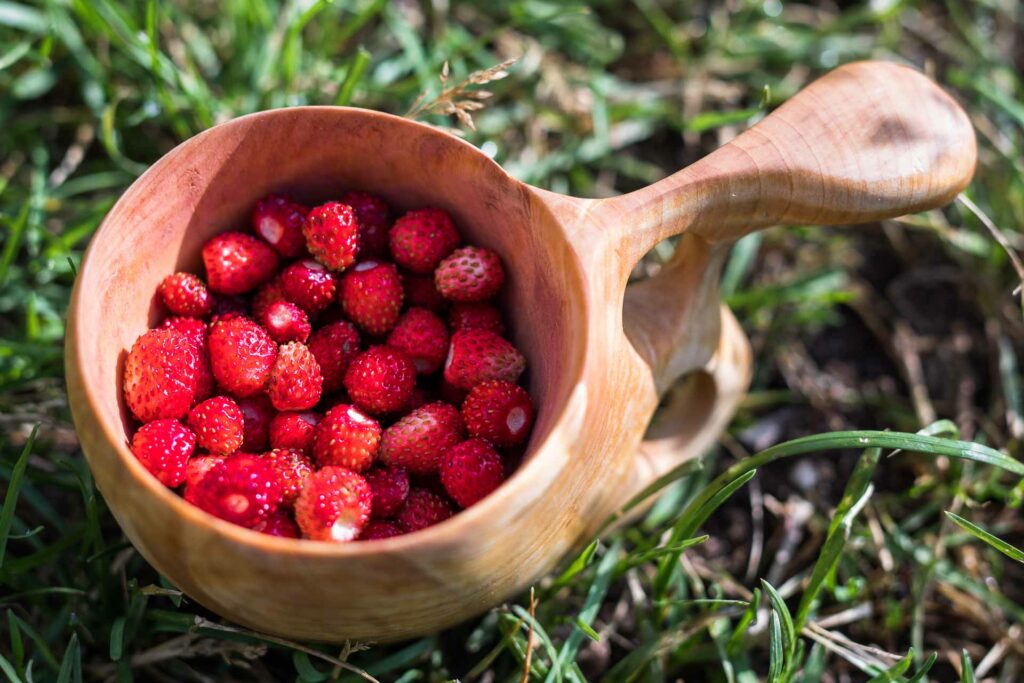Beyond Food- the Renaissance of Foraging
For centuries, people foraging enjoyed harvesting mushrooms, berries and edible plants during the summer months, taking advantage of the most delicious resources. The New Nordic food movement, which took root in 2004, foraging goes beyond food, as a renaissance of a traditional lifestyle. This culinary revolution, led by visionary Scandinavian chefs, has placed foraging at the heart of the dining experience in Sweden's most acclaimed restaurants.

In recent years, a growing number of people have turned to nature to find solace, sustainability, joy and sustenance. Foraging—the ancient practice of searching for wild food, edible plants and mushrooms—is now a fascinating way to reconnect with the natural world. This resurgence is not just about collecting ingredients for a meal but is also closely tied to the broader trend of living off-grid, as more people seek to break free from the constraints of modern, urban life.
A Brief History of Foraging
Foraging is as old as humanity itself. Before the advent of agriculture around 12,000 years ago, humans relied entirely on hunting and gathering for survival. Our ancestors roamed the landscapes in search of edible plants, nuts, berries, mushrooms, and animals, forming a deep connection with the ecosystems they inhabited. These early foragers possessed an intimate knowledge of their environment, understanding the seasonal availability of various foods and the medicinal properties of plants.
With the development of agriculture, foraging gradually became less central to daily life. However, it never disappeared entirely. In many indigenous cultures, foraging remained an essential part of the lifestyle and during times of scarcity—such as wars, famines and economic depressions—people in modern societies also turned back to nature to supplement their diets.
In the 21st century, foraging has experienced a renaissance, spurred by several factors: a growing interest in organic and locally sourced food, concerns about food security, and a desire to reconnect with the natural world. According to a 2020 survey by the Food and Agriculture Organization (FAO), the global foraging community has grown by 15% over the past decade, with millions of people now regularly engaging in this practice.
The Freedom of Foraging: What’s on the Menu?
Foraging is a skill that requires knowledge, patience, and respect for the environment. Edible plants and mushrooms vary greatly depending on location and season, but some of the most commonly foraged items include:
- Herbs: Wild mint, thyme, and sage can be used to flavor dishes or brewed into teas.
- Nuts: Acorns, walnuts, and chestnuts are high in protein and fats, making them a valuable food source.
- Berries: Blackberries, elderberries, and wild strawberries are not only delicious but also packed with antioxidants.
- Wild Greens: Dandelion, nettles and wild garlic are rich in nutrients and can be used in salads, soups and pestos.
- Mushrooms: Morels, chanterelles and porcini are sought after by chefs and home cooks alike for their rich flavors and culinary versatility.
However, foraging is not without its risks. Many wild plants and mushrooms have poisonous look-alikes, so it’s crucial for foragers to be well-informed and cautious. The rise of foragers online communities and mobile apps dedicated to foraging has made it easier for novices to learn, but there is no substitute for hands-on experience, ideally guided by an expert.
Foraging is a trend closely linked with the growing movement of living off-grid—a lifestyle choice that involves disconnecting from centralized utilities and embracing a more self-sufficient existence. Over the past 20 years, living off-grid has shifted from being a fringe activity to a mainstream option, driven by a desire for sustainability, freedom and a simpler life. In the United States alone, it is estimated that over 250,000 people are living off-grid as of 2023, a number that continues to grow but difficult to confirm its accuracy as statistics might fail…
Foraging complements the off-grid lifestyle by providing a source of free, local food that reduces the need for store-bought goods. For many off-gridders, foraging is part of a broader philosophy that values sustainability, resilience and a deep connection to the land. By harvesting wild foods, they reduce their ecological footprint and gain a deeper appreciation for the ecosystems that sustain them.
Foraging is a way to diversify your diet in an off-grid setting. While many off-grid households grow their own food, foraging allows them to access a wider variety of nutrients and flavors. For example, wild mushrooms can be a valuable addition to a diet that might otherwise lack variety during certain seasons. This practice not only enhances food security but also strengthens the relationship between people and the environment.
The resurgence of foraging reflects a broader cultural shift towards valuing nature and sustainability. In an age where food is often mass-produced and shipped thousands of miles before reaching our plates, the act of gathering wild food offers a profound sense of connection to the earth and the seasons. It is a way of reclaiming knowledge that was once commonplace but is now rare, and it challenges us to see the landscape not just as a backdrop to our lives, but as a source of sustenance and wisdom.
As more people embrace foraging and the off-grid lifestyle, we may be witnessing the emergence of a new renaissance—one which is not designed for venturing into unknown territories, but rather rediscovering the ancient practices that allowed humans to thrive in harmony with nature. Modern foragers are not just feeding their bodies but also nourishing their spirits and creating a more sustainable future for all.
The Renaissance of an Old Way of Life
We just returned from Sweden, where vast forests, pristine lakes and pristine countryside offers an ideal landscape for foraging. The practice of gathering wild foods is deeply ingrained in Swedish culture, dating back centuries to when rural populations relied on the land for their survival. Today, foraging in Sweden is not only a cherished tradition but also a growing trend, as more people seek to reconnect with nature and embrace a more sustainable lifestyle.
Sweden-A Forager’s Paradise
One of the unique aspects of foraging in Sweden is the concept of “Allemansrätten,” or the Right of Public Access. This legal principle, enshrined in Swedish law, grants everyone the freedom to roam and enjoy nature, regardless of who owns the land. This right allows Swedes and visitors alike to walk, hike, camp, and forage on most land without needing permission from the landowner.
Allemansrätten is a cornerstone of Swedish outdoor culture and is essential to the widespread practice of foraging. Under this right, Swedes can pick wild berries, mushrooms, and flowers across the country, as long as they do so responsibly and without causing damage to the environment. This open access to nature has fostered a strong connection between the Swedish people and their natural surroundings, making foraging a popular activity for families, outdoor enthusiasts, and culinary adventurers.
Sweden’s diverse ecosystems provide a wealth of wild edibles, varying by region and season. Some of the most popular and abundant foraged foods in Sweden include:
Berries: Sweden is renowned for its wild berries, with blueberries (blåbär), lingonberries (lingon), cloudberries (hjortron), and cranberries (tranbär) being particularly prized. These berries are rich in vitamins and antioxidants and are used in everything from jams and juices to desserts and traditional dishes.
Mushrooms: Sweden’s forests are a haven for mushroom hunters. Chanterelles (kantareller) are the crown jewel of Swedish mushrooms, celebrated for their golden color and delicate flavor. Other sought-after varieties include porcini (Karljohansvamp), morels (murklor), and trumpet mushrooms (trattkantareller). Mushroom foraging is a serious pursuit in Sweden, with many families passing down their secret foraging spots through generations.
Wild Greens and Herbs: Swedes also forage for various wild plants and herbs, such as nettles (nässlor), wild garlic (ramslök), and sorrel (ängssyra). These greens are often used in soups, salads, and as herbal remedies, reflecting a deep-rooted knowledge of plant-based nutrition and medicine.
Nuts and Seeds: While not as commonly foraged as berries and mushrooms, hazelnuts (hasselnötter) and acorns (ekollon) can also be found in Swedish forests, providing a nutritious and protein-rich food source.
Foraged ingredients have long been a staple of Swedish cuisine, contributing to the country’s culinary identity. Traditional Swedish dishes often incorporate wild foods, such as *gravad lax* (cured salmon) served with a sauce made from wild dill, or *palt* (potato dumplings) with lingonberry sauce. In recent years, the “New Nordic” food movement has further elevated the status of foraged foods, with top Swedish chefs showcasing wild ingredients in innovative and gourmet dishes.
Restaurants across Sweden now offer menus that highlight the flavors of the forest, and foraging tours have become a popular way for both locals and tourists to explore the Swedish wilderness and discover its edible treasures. This renewed interest in foraging is not just about the food itself but also about sustainability, local sourcing, and a deeper appreciation for the natural world.
Sweden has seen a growing interest in off-grid living and self-sufficiency. For many Swedes, foraging is a natural extension of this lifestyle, providing a direct connection to the land and a way to reduce dependence on commercial food systems. The Swedish countryside, with its abundant natural resources and relatively low population density, is particularly well-suited to off-grid living.
Swedes who choose to live off-grid often integrate foraging into their daily routines, using wild foods to supplement what they grow in their gardens or raise on their small farms. This practice not only enhances their food security but also reinforces the principles of sustainability and ecological stewardship that are central to the off-grid movement.
As interest in foraging continues to grow, so too does the importance of education and conservation. The Swedish government and various environmental organizations have launched initiatives to promote responsible foraging practices, ensuring that future generations can continue to enjoy the country’s natural bounty. These efforts include guidelines on sustainable harvesting, protection of endangered species, and the preservation of natural habitats.
Foraging in Sweden is more than just a trend—it is a way of life that reflects the country’s deep connection to nature and its commitment to sustainability. Whether gathering mushrooms in a misty forest, picking berries in the summer sun, or simply enjoying the freedom to roam the land, Swedes continue to honor their rich foraging heritage while adapting it to the needs of the modern world. In doing so, they inspire others to reconnect with the earth and find nourishment, both physical and spiritual, in the wild.
Do you want to share your story and inspire our readers ? Know that YOUR EXPERTISE is paving the way for a fairer, happier society.




